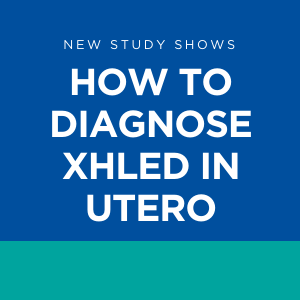By Johanna Hammersen & Holm Schneider
X-linked hypohidrotic ectodermal dysplasia (XLHED) is caused by variants of the gene EDA that result in a lack of the signaling protein EDA1 during development in the womb. Inability to sweat, the major XLHED-associated problem which can lead to life-threatening overheating, has been shown to be amenable to intrauterine therapy with recombinant EDA1.
Our study aimed at evaluating ultrasound-based tooth germ counting as a non-invasive means to identify affected fetuses in pregnant women with a family history of XLHED. Tooth germ sonography was performed in 38 cases at 10 study sites between weeks 18 and 28 of pregnancy.
XLHED was diagnosed if fewer than six tooth germs were detected in the upper and/or the lower jaw.
The diagnostic assessments were verified after birth either by analysis of the EDA sequence or by clinical findings. Estimated weights of 12 affected male fetuses and weight gain of 12 male infants with XLHED were assessed using appropriate growth charts.
The Results
In 19 of 38 sonographic examinations around week 22 of pregnancy (23 male and 13 female fetuses), signs of XLHED were detected. The ultrasound-based diagnosis proved to be correct in 37 cases; one affected male fetus was missed.
Specificity and positive predictive value were both 100%. Tooth counts obtained by clinical examination corresponded well with findings on panoramic dental radiographs. We observed no weight deficits of subjects with XLHED in utero but occasionally during infancy.
Our Conclusions
We conclude from this study that fetal tooth germ sonography is highly specific and reliable in detecting or ruling out XLHED in unborn babies of carrier women.
Such sonographic assessments may be offered in different countries at various sites and would allow recognition of XLHED in time for possible intrauterine therapy or prevention of dangerous hyperthermic episodes in early infancy.
– Drs. Hamersen and Schneider are guest bloggers for the National Foundation for Ectodermal Dysplasias. They are researchers at the University of Erlangen.

I am pregnant and interested in this testing
Hi, Jennifer. Please contact Mary Fete, our executive director, at mary@nfed.org. Thanks, Jodi, NFED, Director, Marketing and Communication
I am interesting in reading this research if it is published please
my daughter is 13 and currently obese i have been to dentists and doctors and have had nobody able enough to tell me or give me any help or even research in the matter of her skin and weight gain would be very happy if someone would contact me from here